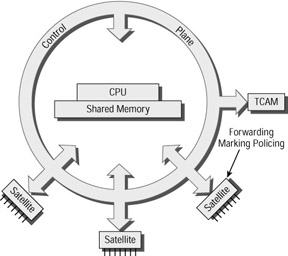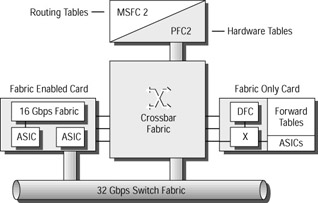Switches: The Current Range
The current Cisco range of switches represents the most powerful yet. Many of them have layer 3 switching capabilities in addition to layer 2, which means that they can almost be configured as a multi-port router. Many also run a version of the IOS as standard. The only two still running the set-based CatOS have an upgrade path to allow them to run IOS. Despite figuring in the current exam, CatOS is doomed.
This next section looks at the four main switch families in turn, and links together the technologies we have discussed so far in this chapter with the real world of Cisco products.
2950 Series Switches
The 2950 series comprises a number of fixed configuration switches that can be operated in a stand-alone fashion or joined together in a stack. There are two distinctly different IOS-based software images (which are platform dependent and not interchangeable), allowing users to purchase the most suitable system for their environment.
The Standard Image (SI) software offers IOS-based basic data, video, and voice services. The Enhanced Image (EI) software provides additional features such as advanced quality of service (QoS), rate limiting, and security filtering for more exposed locations in the topology.
All Catalyst 2950 and 2955 models have the Cisco Cluster Management Suite (CMS) software embedded in the operating system. (CMS is discussed later in this chapter.)
The basic architecture of the 2950 switches is shown in Figure 10.7.

Figure 10.7: 2950 switch architecture
A wide range of switch configurations and port densities is available. You can determine the switch model and the version of the IOS by entering the show version command. Shown next is the output from the show version command executed on a WS-C2950-24 switch (the underlines are mine to highlight the image and switch model):
Terry_2950#show version Cisco Internetwork Operating System Software IOS (tm) C2950 Software (C2950-I6Q4L2-M), Version 12.1(11)EA1, RELEASE SOFTWARE (fc1) Copyright (c) 1986-2002 by cisco Systems, Inc. Compiled Wed 28-Aug-02 10:25 by antonino Image text-base: 0x80010000, data-base: 0x80528000 ROM: Bootstrap program is CALHOUN boot loader Terry_2950 uptime is 19 minutes System returned to ROM by power-on System image file is "flash:/c2950-i6q4l2-mz.121-11.EA1.bin" cisco WS-C2950-24 (RC32300) processor (revision G0) with 20402K bytes of memory. Processor board ID FOC0650W11A Last reset from system-reset Running Standard Image 24 FastEthernet/IEEE 802.3 interface(s) 32K bytes of flash-simulated non-volatile configuration memory. Base ethernet MAC Address: 00:0B:BE:53:2C:00 Motherboard assembly number: 73-5781-11 Power supply part number: 34-0965-01 Motherboard serial number: FOC06500D9W Power supply serial number: PHI06460AS1 Model revision number: G0 Motherboard revision number: A0 Model number: WS-C2950-24 System serial number: FOC0650W11A Configuration register is 0xF Terry_2950#
The 2950 series switches operate only at layer 2, and all use a CAM for address lookup, and a shared memory switching fabric for forwarding frames. Shown next is the output from the show mac-address-table command executed on a WS-C2950-24 switch:
Terry_2950#show mac-address-table Mac Address Table ------------------------------------------ Vlan Mac Address Type Ports ---- ----------- ---- ----- 1 00e0.b063.c196 DYNAMIC Fa0/1 1 00e0.b064.6ee5 DYNAMIC Fa0/2 2 0000.0c76.1f30 DYNAMIC Fa0/3 2 00e0.b063.c197 DYNAMIC Fa0/4 Total Mac Addresses for this criterion: 4 Terry_2950#
The 2950 stores the VLAN information in a separate database file (vlan.dat) from the one used for the configuration files (config.text). Shown next is the output from the show flash command executed on a WS-C2950-24 switch:
Terry_2950#show flash Directory of flash:/ 2 -rwx 2664051 Mar 01 1993 00:04:35 c2950-i6q4l2-mz.121-11.EA1.bin 3 -rwx 269 Jan 01 1970 00:02:46 env_vars 5 -rwx 676 Mar 01 1993 00:48:45 vlan.dat 6 -rwx Mar 03 1993 05:25:47 private-config.text 7 drwx 704 Mar 01 1993 00:05:13 html 19 -rwx 109 Mar 01 1993 00:05:14 info 20 -rwx 109 Mar 01 1993 00:05:14 info.ver 21 -rwx 1580 Mar 03 1993 05:25:47 config.text 7741440 bytes total (3778048 bytes free) Terry_2950#
3550 Series Switches
The 3550 Series Intelligent Ethernet switch comprises a number of fixed configuration switches that can be operated in a stand-alone fashion or joined together in a stack. More powerful than the 2950 switches, they provide several enhancements to both security and Quality of Service (QoS), thanks in part to the additional layer 3 capability of the IOS.
All Catalyst 3550 models have the Cisco Cluster Management Suite (CMS) software embedded in the operating system. (CMS is discussed later in this chapter.)
The 3550 series switches operate using a distributed shared-memory switching fabric. The forwarding decisions, at layers 2, 3, and 4, as well as CEF, are taken by 'satellite' ASICs located near the main shared memory. Figure 10.8 shows the relationship between the shared memory, the decision-making satellite ASICs, and the ring request mechanism.

Figure 10.8: 3550 switch architecture
The 3550 switches operate at both layer 2 and layer 3, and use a CAM for address lookup at both layers for 10/100 Mbits/second interface traffic. All switches in the range use TCAM for faster switching because of the proliferation of Gigabit interfaces. You can tell which version of the switch you are connected to by using the show version command.
Terry_3550#show version Cisco Internetwork Operating System Software IOS (tm) C3550 Software (C3550-I5K2L2Q3-M), Version 12.1(13)EA1a, RELEASE SOFTWARE (fc1) Copyright (c) 1986-2003 by cisco Systems, Inc. Compiled Tue 25-Mar-03 23:56 by yenanh Image text-base: 0x00003000, data-base: 0x008BA914 ROM: Bootstrap program is C3550 boot loader Terry_3550 uptime is 4 days, 23 hours, 10 minutes System returned to ROM by power-on System image file is "flash:/c3550-i5k2l2q3-mz.121-13.EA1a.bin" [output cut] cisco WS-C3550-24-PWR (PowerPC) processor (revision B0) with 65526K/8192K bytes of memory. Processor board ID CAT0709X07M Last reset from warm-reset Bridging software. Running Layer2/3 Switching Image Ethernet-controller 1 has 12 Fast Ethernet/IEEE 802.3 interfaces Ethernet-controller 2 has 12 Fast Ethernet/IEEE 802.3 interfaces Ethernet-controller 3 has 1 Gigabit Ethernet/IEEE 802.3 interface Ethernet-controller 4 has 1 Gigabit Ethernet/IEEE 802.3 interface 24 FastEthernet/IEEE 802.3 interface(s) 2 Gigabit Ethernet/IEEE 802.3 interface(s) Terry_3550#
Shown next is the output from the show tcam command executed on the same switch. Very few entries exist in this TCAM, but the command can be used to view the remaining TCAM capacity.
Terry_3550#show tcam ? inacl Show Ingress ACL TCAM outacl Show Egress ACL TCAM pbr Show PBR TCAM qos Show Ingress QoS TCAM Terry_3550#show tcam qos ? <1-1> TCAM ID Terry_3550#show tcam qos 1 ? entries Show entry information masks Show mask information port-labels Show port label information size Show size statistics Show statistics vlan-labels Show vlan label information Terry_3550#show tcam qos 1 statistics QoS TCAM#1: Number of active labels: 0 QoS TCAM#1: Number of masks allocated: 4,available:412 QoS TCAM#1: Number of entries allocated: 1,available:3327 Terry_3550#
4000 Series Switches
The Cisco Catalyst 4000 Series switches are modular in construction, and are based around the Catalyst 4003 and Catalyst 4006 chassis, both of which operate using a shared memory switching fabric. A range of line cards supporting different arrangements of port numbers and speeds is available and is compatible with both chassis. The Cisco Catalyst 4000/4500 Supervisor Engine IV is the current 'heart' of the machine, comprising a fabric that Cisco defines as supporting, among other features:
-
Integrated resiliency
-
Cisco Express Forwarding (CEF)-based Layer 2/3/4 switching
-
Advanced Quality of Service (QoS)
-
Non-blocking switch fabric forwarding at 48Mbps
(Other Cisco documentation defines the 4000 series switching as 'Layer 2 switching powered by a 24-Gbps, 18-Mbps engine and Layer 3 switching powered by a scalable, 8-Gbps, 6-Mbps engine,' thus allowing you calculate the 48Mbps by yourself.)
Cisco also offer a Catalyst 4500 Series Supervisor Engine II-Plus engine, running Cisco IOS software.
The basic architecture of the 4000 series switches is shown in Figure 10.9.

Figure 10.9: 4000 switch architecture
The model number of the 4000 series and details of the operating system are displayed using the show version command. The following shows the output when the command is executed on a WS-C4003 switch:
Terry_4003 (enable)show version WS-C4003 Software, Version NmpSW: 4.5(2) Copyright (c) 1995-1999 by Cisco Systems, Inc. NMP S/W compiled on Jun 25 1999, 15:53:36 GSP S/W compiled on Jun 25 1999, 15:38:34 System Bootstrap Version: 5.4(1) Hardware Version: 2.1 Model: WS-C4003 Serial #: JAE044001T8 Mod Port Model Serial # Versions --- ---- ---------- ------------------------------ 1 0 WS-X4012 JAE044001T8 Hw : 2.1 Gsp: 4.5(2.0) Nmp: 4.5(2) 2 48 WS-X4148-RJ JAE04271V1N Hw : 2.3 3 34 WS-X4232-GB-RJ JAE043203CK Hw : 2.3 DRAM FLASH NVRAM Module Total Used Free Total Used Free Total Used Free ------ ------- ------- ------- ------- ------- ------- ----- ----- ----- 1 65536K 17723K 47813K 12288K 3764K 8524K 480K 126K 354K Uptime is 183 days, 3 hours, 32 minutes Terry_4003 (enable)
The bridging table in a 4000 series switch is held in the CAM. While this is considered fast enough for the 10/100 interfaces, the Gigabit Ethernet interfaces need more speed, and so a TCAM is used for both layer 2 and layer 3 lookup when the faster interfaces are installed.
Shown next is the output from the show cam command executed on a WS-C4003 switch. Note that it is possible to see either dynamic or static entries, and also to have them displayed by VLAN.
Terry_4003 (enable) show cam Usage: show cam [count] <dynamic|static|permanent|system> [vlan] show cam <dynamic|static|permanent|system> <mod_num/port_num> show cam <mac_addr> [vlan] show cam agingtime Terry_4003 (enable) show cam dynamic * = Static Entry. + = Permanent Entry. # = System Entry. R = Router Entry. X = Port Security Entry VLAN Dest MAC/Route Des Destination Ports or VCs / [Protocol Type] ---- ------------------ ------------------------------------------ 1 00-00-00-1d-f0-b6 2/26 [ALL] 1 00-00-85-07-7d-ba 2/25 [ALL] 1 00-02-a5-03-69-e0 2/23 [ALL] 1 00-02-a5-09-ef-08 2/31 [ALL] 1 00-02-a5-09-ef-14 2/43 [ALL] 1 00-02-a5-0c-ab-01 2/36 [ALL] 1 00-02-a5-0c-f9-c7 2/46 [ALL] 1 00-02-a5-22-8f-b4 2/24 [ALL] 1 00-02-a5-31-ac-d8 2/32 [ALL] [output cut]
6500 Series Switches
The 6500 series switches use a crossbar switching fabric. This is good, because as the heart of the Cisco high-end range, they are widely used as core switches, and need to ensure non-blocking throughput at very high speeds.
| Note | The 6500 series switches have 8 usable slots, with 2 fabric channels per slot and 8 Gigabits/sec per fabric channel, providing an advertised 256 Gigabits/second (full-duplex) switching fabric. |
A TCAM lookup mechanism is applied to the architecture for the fastest possible address- matching decision, and the actual forwarding mechanism is assisted by a distributed forwarding mechanism using the Distributed Forwarding Card. (This is similar to the satellite ASICs in the 3550 series.)
In addition, the 6500 series gains a large increase in throughput speed by using a process called Demand-Base Switching. This involves updating an ASIC-based cache with information from the first layer 3 packet forwarded at routing table speeds, and then switching the rest of the packets along the same path. The use of ASICs to manage this table increases the throughput by a factor of thousands. This is in addition to standard fast CEF table. The basic architecture of the 6500 switches is shown in Figure 10.10.

Figure 10.10: 6500 switch architecture
You can select the options you need in this modular architecture, taking into account both cost and requirements. For example, line cards can be installed with several configuration options, including:
-
Classic line cards: bus connectivity only
-
Fabric-enabled line cards: switch fabric and bus connectivity
-
Fabric-only line cards: dual switch fabric, no bus connectivity
-
Switch fabric: line cards that contain the actual 256 Gigabits fabric
Note For details of the full range of line cards available for the 6500 series, see the Cisco website for the most up-to-date details: www.cisco.com/en/US/products/hw/switches/ps708/products_data_sheets_list.html.
EAN: 2147483647
Pages: 174